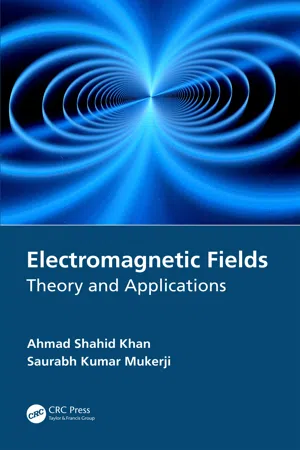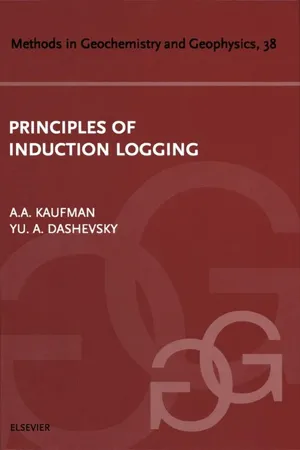Physics
Magnetic Flux Density
Magnetic flux density, also known as magnetic field strength, is a measure of the strength of a magnetic field. It is defined as the amount of magnetic flux passing through a unit area perpendicular to the direction of the magnetic field. The SI unit for magnetic flux density is the tesla (T).
Written by Perlego with AI-assistance
Related key terms
3 Key excerpts on "Magnetic Flux Density"
- eBook - ePub
- Michael M. Mansfield, Colm O'Sullivan(Authors)
- 2020(Publication Date)
- Wiley(Publisher)
Chapter 16 .As before, the total flux from a source is also used as a measure of the strength of the source. Thus the flux concept is carried over to the case of magnetic fields simply by defining the total magnetic flux(ΦM )from a pole as being equal to the magnetic pole strength, that isEven when the magnet is not long and thin (such as in Figure 18.2 (a)), the pole strength can be defined as the total flux emanating from the N pole end (or sinking at the S pole).The intensity at some point in a magnetic field can be measured in terms of the magnetic flux per unit area at that point. Thus a vector quantity, called the Magnetic Flux Density is defined bywhereΔΦMis the magnetic flux through an areaΔAwhich is perpendicular to the field lines through the point and is a unit vector tangential to the field lines, that is perpendicular to ΔA, as illustrated in Figure 18.18 . The SI unit of Magnetic Flux Density isWb m−2, called the tesla (after Nikola Tesla 1856–1943), that is,1 tesla = 1 Wb m−2 = 1 T.1Figure 18.18ΔΦMis the magnetic flux through the areaΔA. The Magnetic Flux Density B is directed perpendicularly to the areaΔA, that is, tangentially to the local magnetic field line.From the definitions presented above, both the Magnetic Flux Density B and the magnetic field strength H at a point in a non‐conducting medium are directed along the tangent to the local magnetic field line through that point ( in Figure 18.18 ). Thus B is parallel to H, that isThe value ofμdepends on the nature of the medium in which the currents and/or magnetic poles which give rise to the magnetic field and the field itself are immersed. The quantityμ, therefore, is a property of the medium and is called the permeability of the medium. The distinction between B and H will become clearer in Section 19.9 - eBook - ePub
Electromagnetic Fields
Theory and Applications
- Ahmad Shahid Khan, Saurabh Kumar Mukerji(Authors)
- 2020(Publication Date)
- CRC Press(Publisher)
charge enclosed . These terms appear to be quite simple but in essence each of these has a specific meaning and needs proper explanation. In the next subsection, an attempt has been made to address the same.6.2.1 Flux and Its Dependence
The term flux is an important entity. It encompasses the fields of mathematics, electricity, and magnetism. In mathematics its concept helps us to understand the divergence discussed in Section 4.3. In general, it may be conceived as the amount of “something” crossing a surface. The word “something” may include water, gas, wind, electric flux (Ψ), magnetic flux (Φ), electromagnetic energy (ϵ ), or anything else that has the capability to cross. The total of this something depends on the strength of its source and the way it is crossing out. It also depends on the shape, size, and the orientation of the surface it crosses. For the rest of this chapter, the word something will be replaced by the electric flux referred in Gauss’ law.One should keep in mind that the source of flux is a vector field and the flux in itself need not necessarily be a physical object or quantity. The surface referred to in Gauss’ law is the closed boundary surface through which the flux is crossing. A part of this closed boundary surface may be a part of a sphere, a flat or curved plane, or the top of a bucket. Furthermore, this boundary need not be a physical entity and may comprise an imaginary sphere, cylinder, or a plane. The timing is another parameter to be reckoned with. It is the single time instant at which the total flux is measured. This is not to be taken in terms of per unit area. This total flux is closely related to the source, as the flux passing through a surface will be doubled if the source gets doubled.The meaning of “surface” was explained in Section 4.6.2. A closed surface may be composed of a number of open surfaces. An open surface is another important parameter which plays a significant role. The total flux through this open surface depends on the relative orientations of the field and the area of surface. Whenever a surface completely faces the field, it passes the maximum flux. An analogy can be drawn to a sail facing the wind. The wind will exert maximum pressure on the sail if the sail and wind are perpendicular to each other or if the sail completely faces the wind. When the surface of the sail tilts away from the wind, the pressure will be reduced and will be zero when the sail and wind become parallel to each other. Similarly, when the surface to be crossed by the flux tilts away from the field, the crossing flux decreases until it becomes zero when the field and boundary are parallel, i.e. the flux is along the boundary and not crossing through the boundary surface. The magnitude of total flux will also depend on the size of surface. In the same field, a larger surface will capture more flux than a smaller one. - eBook - ePub
- Avital Kaufman, Yu.A. Dashevsky(Authors)
- 2003(Publication Date)
- Elsevier Science(Publisher)
0 and the EMF in the toroid are related through the formula:E =E 0e= −− i ω t∂∂ tψ 0e= i ω− i ω tψ 0e− i ω t(2.61)On the other hand, the electromotive force is equal to the integral of the electric field along the closed path surrounding the magnetic flux:E =∮E 0d l = 2 π rE0 ϕ(2.62)because the field is characterized by axial symmetry. It follows from eqs. 2.60 –2.62 that the electric fieldEϕalong a toroidal ring is:E=0 ϕ=i ωψ 02 π ri ω μ4 πrM TR 3(2.63)It is clear the EFrom this we obtain the expression for the current density at any point of the toroid:0ϕis the primary vortex electrical field caused by a change of the primary magnetic field with time only.J= σ0 ϕE=0 ϕi σ μ ω4 πrM TR 3(2.64)The physical meaning of this last expression should be obvious: it is the current density induced by the primary magnetic field of the dipole source alone. As can be seen from eq. 2.64 the current density J0ϕis shifted by 90 ° in phase with respect to the current of the source. If we could neglect any secondary effects caused by magnetic field accompanying induced currents in the medium the character of the current distribution could be defined precisely by eq. 2.64 .In this case the current density at any point in the medium depends on the distance from the source, and on the angle θ , that is, on geometric parameters only and it is directly proportional to the transmitter moment, conductivity, frequency and magnetic permeability. One can say that the actual distribution of the current density in a conducting medium could be described by J0ϕ, if the effect of interaction between currents, that is, the skin effect, were to be negligible. Graphs of function J0ϕin planes perpendicular to the dipole axis are shown in Fig. 2.7 . It can be seen that with increasing z the radius of the ring with maximum current also increases.Figure 2.7 Curves showing the current density in planes perpendicular to the z -axis as a function of the distance r
Index pages curate the most relevant extracts from our library of academic textbooks. They’ve been created using an in-house natural language model (NLM), each adding context and meaning to key research topics.


